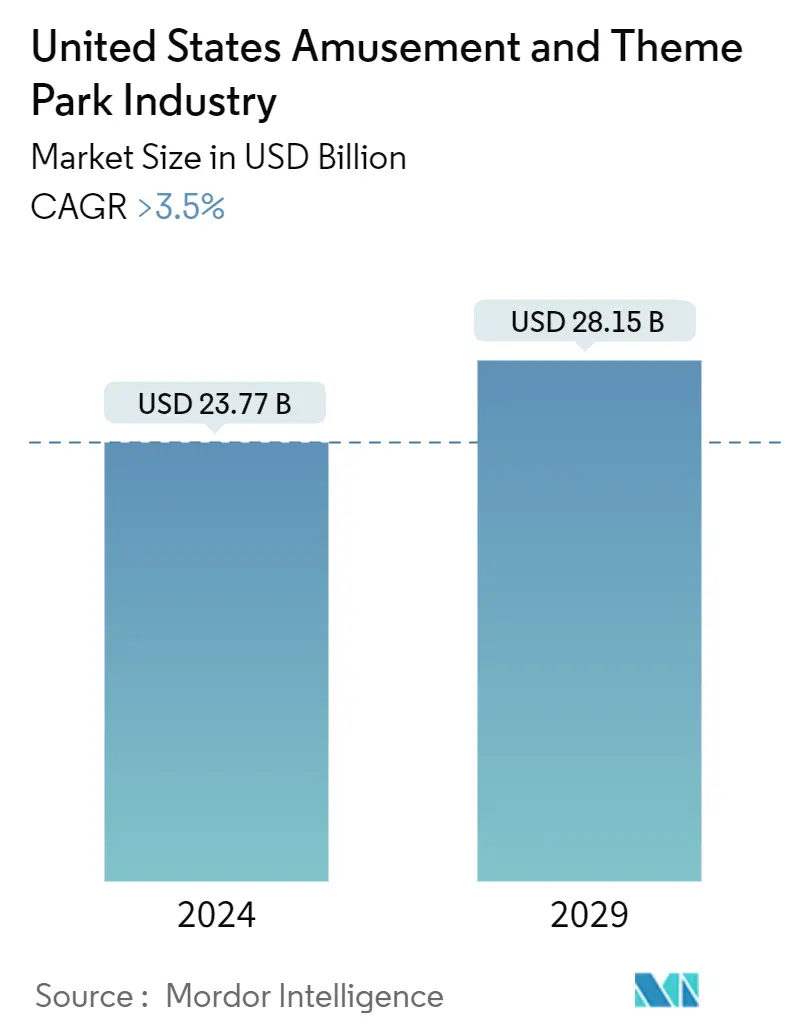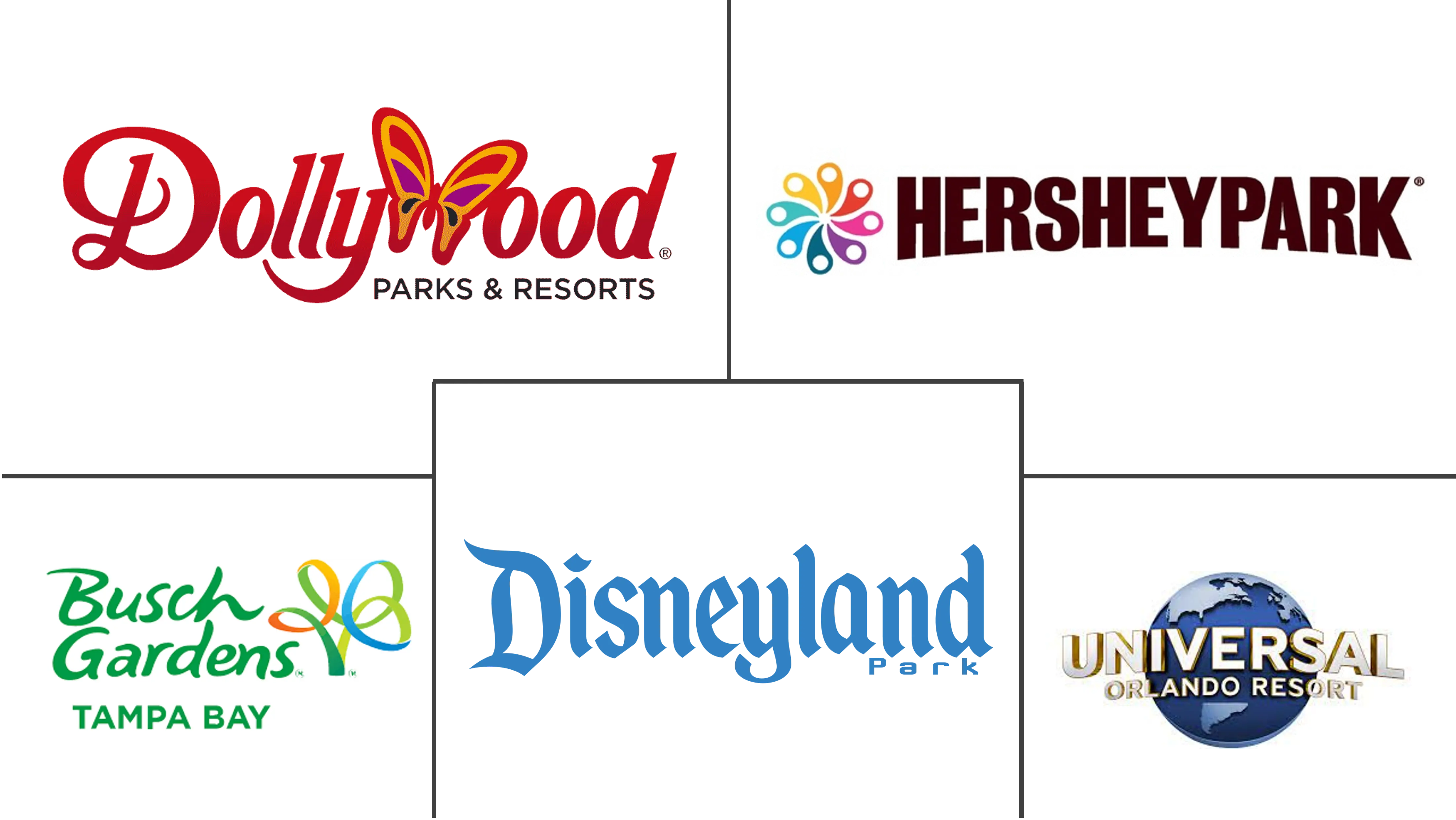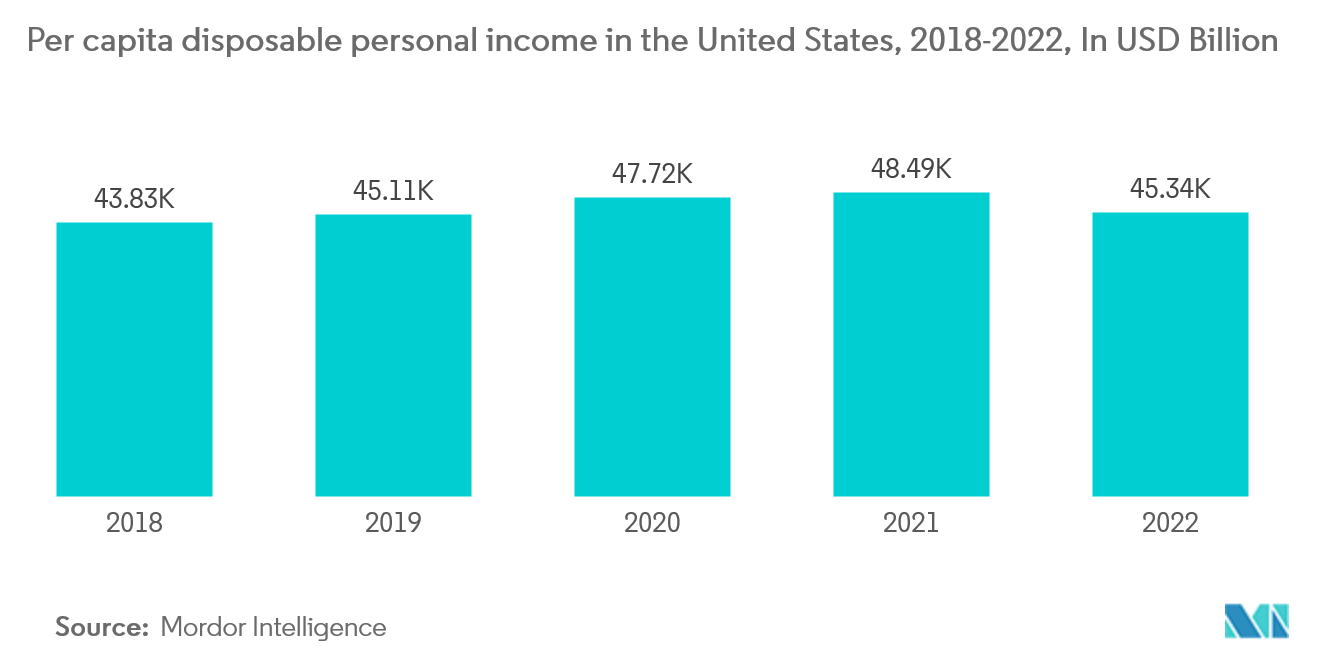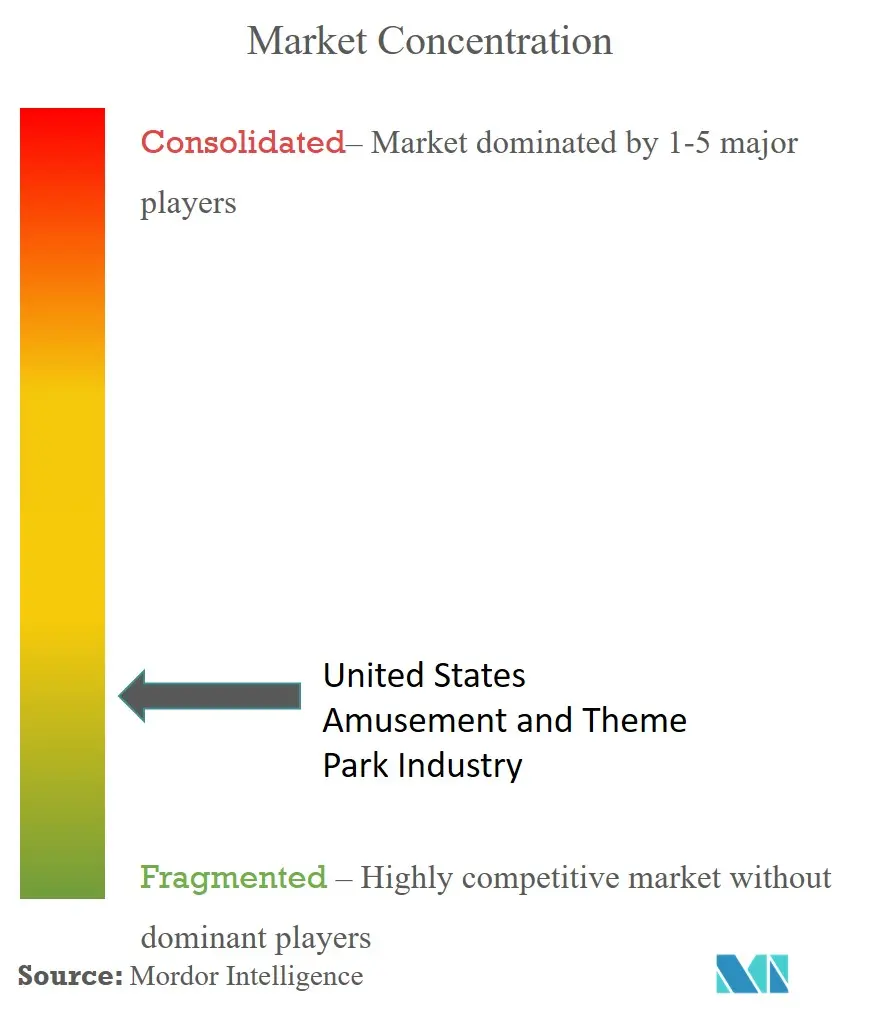US Amusement and Theme Parks Market Size

| Study Period | 2020-2029 |
| Base Year For Estimation | 2023 |
| Market Size (2024) | USD 23.77 Billion |
| Market Size (2029) | USD 28.15 Billion |
| CAGR (2024 - 2029) | 3.50 % |
| Market Concentration | Low |
Major Players
*Disclaimer: Major Players sorted in no particular order |
US Amusement and Theme Parks Market Analysis
The United States Amusement And Theme Park Industry is expected to grow from USD 23.77 billion in 2024 to USD 28.15 billion by 2029, at a CAGR of greater than 3.5% during the forecast period (2024-2029).
The market growth is a result of the increasing adoption of technological advancements in the form of augmented and virtual reality. The inculcation of advanced motion simulators, hydraulics, and pneumatics, along with the focus on customers’ experience, is expected to increase the market demand in the coming years. In recent years, more theme parks have begun to incorporate advanced technology into their rides and displays to enhance their experiences. The competition within the industry has increased with the introduction of AR & VR gaming centers, live concerts, and movie theatres that require comparatively less time and ensure a great experience.
In the United States, many theme parks have competed for the right to incorporate intellectual property from popular movies and television productions into their entertainment. Disneyland, for instance, has often relied on animated characters designed by Walt Disney. The Chinese tourists, overall, are the third-largest source of overseas tourism after the UK and Japan to the United States, of which around 47% prefer to visit the amusement parks as their prime location.
The theme park business peaked in 2019, the year before the COVID-19 virus forced several parks and attractions to close for a while before reopening with visitation limitations. Additionally, the theme parks discovered methods to extend the dates of popular special events like Halloween celebrations at Universal, Six Flags, and Cedar Fair parks, which drew local tourists. Travel restrictions during the height of the epidemic reaction impacted the domestic visitor sector, which drove attendance in Orlando, Florida, the theme park capital of the United States.
US Amusement and Theme Parks Market Trends
Increase in the number of visitors in amusement and theme parks
The popularity of experiential travel saw a surge in recent years, particularly in the aftermath of the COVID-19 pandemic, and amusement & theme parks, which have traditionally been synonymous with this type of travel, are re-emerging as popular destinations for tourists. Major theme parks, such as Disney Parks & Resorts and Universal Theme Parks, as well as Legoland, Genting, and others, are all experiencing a strong recovery in both attendance and expenditure. For example, Disney has reported a 40% rise in theme park spending per capita in 2022 compared to the previous year. Themed Entertainment Association's (TEA) annual report for 2022 revealed a 32% increase in theme park attendance for North America's most significant attractions, with Walt Disney World's Magic Kingdom (Walt Disney World) leading the way. According to the report, Magic Kingdom attracted a total of around 18 million visitors during the 50th Anniversary Celebration of the resort in 2022.

The rise in disposable income is fueling the growth of the market
Consumers are increasingly spending money to experience things rather than to purchase items to fill their leisure time. They are contributing to this by using their discretionary funds to pay for unique, individualized experiences, thus contributing to the experience economy. Social media is essential in influencing consumers to create an increased demand for these experiences. Individuals of all ages, particularly corporate professionals, are drawn to amusement parks to spend quality time in a pleasant, family-friendly atmosphere. The expansion of the amusement park market revenue can be attributed to a variety of factors, including changing lifestyles, cultural changes, and the increasing acceptance of a holistic lifestyle that combines work and leisure.

US Amusement and Theme Parks Industry Overview
The market is relatively fragmented, with around 20% of the market share held by the top five companies, including Dollywood, Hersheypark, Disneyland Park, Busch Gardens Tampa Bay, and Universal Orlando Resort. With the advancement in social media marketing and technological updates, consumers are looking forward to a personalized experience in terms of their itinerary planning and bookings.
The companies in the industry are focusing on acquiring the relevant IPs incurring the least possible cost. One of the strategies used by the companies to create a competitive advantage for themselves is by creatively using the already existing underutilized IPs integrated with the current trends and uniquely presenting them.
US Amusement and Theme Parks Market Leaders
-
Dollywood
-
Hersheypark
-
Disneyland Park
-
Busch Gardens Tampa Bay
-
Universal Orlando Resort
*Disclaimer: Major Players sorted in no particular order

US Amusement and Theme Parks Market News
- September 2023: Crescent Real Estate LLC acquired the Element Orlando Universal Blvd., a 165-key hotel operated under a franchise agreement with Marriott International. Located just outside the confines of the mixed-use development known as Icon Park, Element Orlando hotel guests have immediate access to 20 acres of entertainment opportunities.
- July 2023: Asacha Media Group, a European consolidator, acquired a majority share in Arrow International Media, the producer of Disney's Animal Kingdom. Asacha has financed the Arrow acquisition through a mix of equity from existing shareholders and debt financing from Tikehau Capital.
United States Amusement And Theme Park Industry Market Report - Table of Contents
1. INTRODUCTION
- 1.1 Study Assumptions & Market Definition
- 1.2 Scope of the Study
2. RESEARCH METHODOLOGY
3. EXECUTIVE SUMMARY
4. MARKET DYNAMICS
- 4.1 Market Overview
-
4.2 Market Drivers
- 4.2.1 The number of baby-boomer tourists is expected to increase, which will fuel the growth of the worldwide amusement park market.
- 4.2.2 Incorporating energy-saving innovations like LED lighting and solar panels
-
4.3 Market Restraints
- 4.3.1 Theme parks are raising admission costs and letting guests ride every ride without waiting in queue
- 4.3.2 Theme parks utilising virtual reality are becoming more and more common.
-
4.4 Market Opportunities
- 4.4.1 Blockchain and virtual assistants are being used more and more.
- 4.4.2 New technological advances are being driven by labour shortages and growing security concerns.
-
4.5 Porter's Five Forces Analysis
- 4.5.1 Bargaining Power of Suppliers
- 4.5.2 Bargaining Power of Buyers/Consumers
- 4.5.3 Threat of New Entrants
- 4.5.4 Threat of Substitute Products
- 4.5.5 Intensity of Competitive Rivalry
- 4.6 Impact of COVID-19 on the market
- 4.7 Insights on Revenue Flows from Accommodation and Food and Beverage Sectors
5. MARKET SEGMENTATION
-
5.1 By Type
- 5.1.1 Land Rides
- 5.1.2 Water Rides
- 5.1.3 Other Types
-
5.2 By Source of Revenue
- 5.2.1 Tickets
- 5.2.2 Foods & Beverages
- 5.2.3 Merchandise
- 5.2.4 Hospitality
- 5.2.5 Other Source of Revenues
6. COMPETITIVE LANDSCAPE
- 6.1 Market Concentration Overview
-
6.2 Company Profiles
- 6.2.1 Disney Parks
- 6.2.2 Universal Parks and Resorts
- 6.2.3 Six Flags Inc
- 6.2.4 Cedar Fair Entertainment Company
- 6.2.5 Seaworld Parks and Entertainment
- 6.2.6 Magic Kingdom Park
- 6.2.7 The Island in Pigeon Forge
- 6.2.8 Silver Dollar City
- 6.2.9 Busch Garden
- 6.2.10 Hersheypark
- 6.2.11 Dollywood
- 6.2.12 Dells Waterpark*
- *List Not Exhaustive
7. FUTURE MARKET TRENDS
8. DISCLAIMER
** Subject To AvailablityUS Amusement and Theme Parks Industry Segmentation
An amusement park is a type of theme park that features a variety of attractions, such as rides, games, and other activities. Amusement parks are distinct from theme parks, which focus their buildings and attractions around a single theme and often have multiple regions with different themes. The United States amusement and theme park industry is segmented by type (land rides, water rides, and other types) and by source of revenue (tickets, food and beverages, merchandise, and other sources of revenue).
The report offers market size and forecasts for the United States Amusement & Theme Park Industry in value (USD) for all the above segments.
| By Type | Land Rides |
| Water Rides | |
| Other Types | |
| By Source of Revenue | Tickets |
| Foods & Beverages | |
| Merchandise | |
| Hospitality | |
| Other Source of Revenues |
United States Amusement And Theme Park Industry Market Research Faqs
How big is the United States Amusement And Theme Park Industry?
The United States Amusement And Theme Park Industry size is expected to reach USD 23.77 billion in 2024 and grow at a CAGR of greater than 3.5% to reach USD 28.15 billion by 2029.
What is the current United States Amusement And Theme Park Industry size?
In 2024, the United States Amusement And Theme Park Industry size is expected to reach USD 23.77 billion.
Who are the key players in United States Amusement And Theme Park Industry?
Dollywood, Hersheypark, Disneyland Park, Busch Gardens Tampa Bay and Universal Orlando Resort are the major companies operating in the United States Amusement And Theme Park Industry.
What years does this United States Amusement And Theme Park Industry cover, and what was the market size in 2023?
In 2023, the United States Amusement And Theme Park Industry size was estimated at USD 22.94 billion. The report covers the United States Amusement And Theme Park Industry historical market size for years: 2020, 2021, 2022 and 2023. The report also forecasts the United States Amusement And Theme Park Industry size for years: 2024, 2025, 2026, 2027, 2028 and 2029.
What are the key trends shaping the US Amusement and Theme Parks Market?
The key trends shaping the US Amusement and Theme Parks Market are a) Incorporation of advanced technology into rides and displays to enhance visitor experiences b) Increasing adoption of technological advancements in the form of Augmented Reality (AR) and Virtual Reality (VR) c) Inculcation of advanced motion simulators, hydraulics, and pneumatics
United States Amusement And Theme Park Industry Industry Report
The United States amusement and theme park market is experiencing significant growth, driven by the increasing popularity of specialized theme parks that offer immersive experiences themed around various destinations. The adoption of advanced technologies such as virtual reality, augmented reality, and artificial intelligence is enhancing the visitor experience, making attractions more engaging and efficient. This diverse market includes theme parks, water parks, adventure parks, and zoo parks, featuring a variety of mechanical and water rides.
The market is characterized by its broad demographic appeal and multiple revenue streams, including ticket sales, food and beverages, merchandise, and hospitality. Sustainable practices, such as the use of clean energy sources, are also gaining traction among environmentally conscious consumers, further propelling market growth.
Comprehensive industry analysis, including market size, market share, market analysis, and market forecast, is available in detailed industry reports by Mordor Intelligence™. These reports provide a historical overview and a forecast outlook, offering valuable insights into market trends, market growth, and market leaders. For stakeholders within the amusement park industry and theme park companies in the US, these reports are essential, providing actionable insights and highlighting significant industry trends.
The market review includes industry research, industry sales, industry size, industry statistics, and industry trends. The market outlook and market predictions are crucial for understanding the market value and market segmentation. Detailed market data and industry information are encapsulated in the report PDF, which serves as a report example for those interested in the market overview and market forecast.
In summary, the United States amusement and theme park market is poised for continued growth, driven by technological advancements, diverse revenue streams, and a commitment to sustainability. The industry reports and market research provide a comprehensive understanding of the market dynamics, making them invaluable resources for industry stakeholders.



